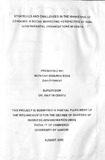| dc.description.abstract | This study was conducted over the period between, July 2001 and
completed in July 2002. The study sought to establish the state of
marketing of condoms in Kenya and specifically addressed the following
three objectives:
1. To establish the types of condoms marketed in Kenya.
2. To identify the current strafegies used in Marketing Condoms in
Kenya.
3. To determine the challenges faced in the marketing of condoms in
Kenya.
This topic was selected owing to the fact that this is a very current issue
that has raised major concerns amongst Kenyans, on whether condoms
should be marketed aggressively and how this should be done. The
population of study included the NGOs, listed in the Directory of Non
Governmental Organizations under reproductive health, which confirmed
to be marketing condoms in Kenya.
A semi-structured questionnaire was used to collect data (See Appendix
II), and below is a summary of the findings:
To address the first objective, it was established that NGOs in Kenya are
mainly marketing the male condoms. and the female condoms are seldom
marketed. Very little marketing research is being done with regard to the
consumer's wants and needs in order to meet their requirements. Only
25% of the sampled population indicated they have a marketing
department, which perhaps explains the low usage of the commercial
marketing strategies used to increase the effectiveness of social
marketing. Program officers, or research managers, who did not have a
good knowledge of how to apply the marketing concepts into social
marketing, carried out most of the marketing functions. This led to one of
the major recommendations made by this study, that future marketers of
condoms need to consider having a marketing department, that would
plan, implement and evaluate marketing strategies which hopefully should
increase the usage of condoms in Kenya.
The second objective established that various marketing strategies were
adopted in Kenya. The most common were social marketing strategies,
which included social and educational campaigns mainly the use of peer
counseling. Others that were fairly common included print media materials
such as pamphlets, posters and brochures. These have proved most
effective in creating awareness and education on how to use condoms.
The least common used strategies were product differentiation and pricing
strategies. The findings indicated that these were limited owing to the fact
that there is no condom production in Kenya at the moment, and the non
profit making objective of NGOs hindered the application of most preferred
pricing strategies. Perhaps the introduction of the proposed condom
factory in Kenya will lead to the use of most of these strategies currently
not in use.
The third objective, sought to establish the major challenges facing
condom marketing in Kenya. There were about fourteen challenges
mentioned and these were weighted to measure their significance using
percentages. The major challenges scoring 100% were social stigma
associated with the use of condoms in Kenya, as many people associate
them with immorality. There is serious opposition mainly from the religious
circles that the government should not promote the use of condoms to
reduce the spread of sexually transmitted diseases especially the killer
AIDS/HIV. Most of the lobby groups opposing the use of condoms are
advocating chastity and abstinence amongst the youth as the way forward
on this subject.
Despite all these controversies, marketers of condoms still have to face the
challenge of how they will market condoms effectively to increase their
use, given that so far, researchers have confirmed condoms to be most
effective barrier method against sexually transmitted diseases. | en |

